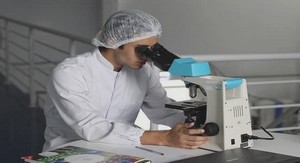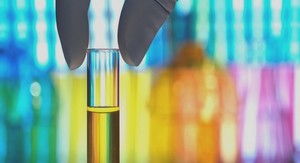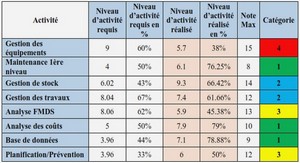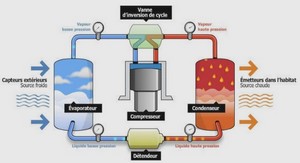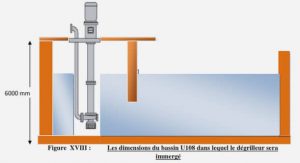Télécharger le fichier original (Mémoire de fin d’études)
Hanbury-Brown and Twiss experiments with microwave pho-tons
Our motivations for the second part of this thesis are the study of the statistics of photons, produced by electronic shot noise in a phase coherent conductor [29], and the detection of quantum noise and zero point fluctuations [21, 22]. The first step, presented here, is to realize an experimental set-up able to measure high frequency shot noise, and moments of order 3 or 4 of the statistics of charge transmitted through a mesoscopic conductor. “High” frequency means that we are not in the zero frequency limit as in the previous paragraph, but we want to be able to see the noise dependence with frequency. The energy scale of noise variation is kB T , T being the electronic temperature. The final set-up will be inserted in a dilution refrigerator able to reach 10 mK, which corresponds to 0.2 GH z. That is why we chose to use low noise cryogenic amplifiers with a bandwidth between 1 and 2 GH z. In order to reach the fourth moment of current, we use a square law detector, giving a signal proportional to the instantaneous power in the circuit, d.c. power excluded, (P = R(ΔI)2), so that we can measure noise power fluctuations :
(ΔP )2 = R2 (Δ(ΔI)2)2
= R2 (ΔI)4 − R2 (ΔI)2 2
R is the resistance used to measure the noise, and I is the current through it. Since we deal with electrical power in coaxial cables, we can also describe the system in terms of photon detection. Actually, electrical current is coupled to electromagnetic modes inside the cable, and the noise power can be seen as a photon power. The square law detector equivalently gives the instantaneous photon power emitted by the conductor. A spectrum analyzer at the output of the detector can give the photon power fluctuations. This set-up is also able to measure the statistics of photons produced by a conductor (but only up to the second moment).
In this thesis, we present the first test of the system efficiency in terms of photon detection. We studied the statistics of photons emitted by a macroscopic resistor, and showed experimen-tally that the photon noise is super Poissonian, since the resistor is a black body radiation source : (ΔP )2 ∝ P 2. A second test of the measurement system has consisted in studying another statistics : a monochromatic radiofrequence source is shown to generate Poissonian noise ( (ΔP )2 ∝ P ), with a giant Fano factor determined by the amplifier noise.
To study the statistics of photons, we use the method introduced by Hanbury-Brown and Twiss (HB&T) [37, 38], which consists in intensity interferometry : two photons sources are “mixed” by a splitter, as shown on the left side of Fig. (5), reflected and transmitted beam intensities are correlated. Since the incident state is a many particle state, then the results of correlations depend on the particle statistics, even if particles are non interacting. In the GHz range, the incident beam is divided by a splitter (right side of Fig. (5)), which includes the source b, which is a built-in 50 Ω impedance so that there is a perfect impedance match. The 50 Ω impedance at T = 0 K is equivalent to the vacuum channel in optical experiments.
Our experimental set-up is schematized on Fig. (6). It consists in two measurement channels, containing each a cryogenic low noise amplifier (its noise temperature is about 6 K), a bandpass filter (its bandwidth is ΔF1,2 ≃ 1 GH z), a second amplification stage at room temperature, a square law detector. The continuous part of the signal at the detector output is proportional to the mean power. The output signal is filtered and injected in the spectrum analyzer, then we can measure the power fluctuations on a bandwidth Δf = 150 kH z. The measurement time is thus much longer than the response time of the detector (1 µs).
Let us now present experimental results concerning a thermal source, which is a 50 Ω resistance, and a classical monochromatic RF source.
Thermal sources : incoherent black body radiation
The scattering theory of noise can be generalized for photons, and the theoretical results concerning respectively the mean power, the autocorrelation of power fluctuations and cross correlations are :
P1 = (Df + Rf0) hν dν
(ΔP1)2 = 2 (Df + Rf0)(1 + Df + Rf0) (hν)2 dν
ΔP1ΔP2 = 2 DR(f − f0)2 (hν)2 dν
In these equations, f is the Bose-Einstein distribution of source a at temperature T , and f0 is the Bose Einstein distribution of source b, at temperature T0 = 4.2 K since the splitter is at liquid helium temperature. The power fluctuations are expressed in W 2/H z, which means we already took into account the measure bandwidth Δν. Source a temperature is varying between 4 and 25 K, and the frequency of detected photons is around 1 GH z, so that we can write f ≃ kB T /hν and f0 ≃ kB T0/hν. Moreover, for a splitter, D = R = 1/2, and if we take into account the amplifier noise temperature TN , then the expected expressions are :
P1 = kB T + T0 + TN,1 ΔF1 (3) T T0 2
(ΔP1)2 = 2 kB + + TN,1 ΔF1 (4) T T0 2
ΔP1ΔP2 = 2 kB − ΔF (5)
We find the classical result that the power fluctuations are proportional to the square of the mean power. Cross correlations are not sensitive to the amplifier noise, and they disappear as soon as both of the sources are at the same temperature. The experimental results are presented on Fig.(7). We plotted the mean power and the correlations in terms of temperature as a function of T /2 (T − T0 for the cross correlations). As expected theoretically, our experimental data points are perfectly aligned. The slope, expected to be 1 are 20 % larger. We explain this difference by the uncertainty of our calibration with a network analyzer. The set-up has been modified between the calibration and the measurement (just by connecting and disconnecting cables), so the impedance mismatches are not exactly the same and it can explain such a difference in the gain. However, we can conclude that we observed the super Poissonian photon noise of a thermal source, since the power fluctuations are proportional to the square of the mean power.
Monochromatic coherent source : Poissonian statistics
To furhter test our experimental system, we used as source a a monochromatic coherent source. The output state is a coherent superposition of coherent states |αν [39], where |αν | is a sharply peaked function around the central frequency ν0. For such an incident state, we can generalize the scattering theory, and one gets : (ΔP )2 = 2 hν0 P
The statistics of emitted photons is Poissonian. But in our experiment the source signal (∼ 1 mW ) is attenuated before arriving on the splitter (∼ 10−13 mW ), and then amplified. And the questions raised here are : does attenuation change the source statistics ? what is the splitter role on the statistics ? and how does the amplifiers change the input photons statistics ? In quantum mechanics, we can model an attenuator or an amplifier by its action on the bosonicL.
We can then apply the scattering theory and calculate power fluctuations in the real case, where the source signal is attenuated, splitted, and then amplified :
(ΔP1)2 = 2 hν0 F P (6)
ΔP1ΔP2 = 0 (7)
The main result is that neither amplification nor attenuation have any effect on the statistics : the hallmark of a Poissonian statistics, that is the absence of cross correlations remains. But in the expression of autocorrelations, a giant Fano factor F appears. In our experimental case, the temperature T0 of the attenuator and splitter (4.2 K), and the noise temperature of the amplifiers (∼ K) are much larger than hν0, and we have : F = 2 kB (T0 + TN ) hν0
Without amplification nor attenuation, the Fano factor should be one. Instead, here, we expect it to be around 300. Experimental results are shown on Fig. (9), for a central frequency ν0 = 1.5 GH z. We plotted autocorrelations and cross correlations (star symbols) expressed in terms of power as a function of the input power. We observe no cross correlations : they remain negligible in front of autocorrelations. And the latter is perfectly linear with the input power. We find experimentally the slope : F = 360, in accordance with the order of magnitude of T0 and TN .
As a conclusion, we can say that our experimental set-up has been successfully tested, with the accurate determination of the photons statistics of two kind of sources : a thermal source, giving an incoherent radiation, and a coherent source, whose statistics is Poissonian. The way is open to measure the statistics of photons produced by electronic shot noise in a mesoscopic conductor.
Les échelles de longueur dans un conducteur
Dans ce paragraphe, nous allons mentionner les différentes échelles de longueur intervenant dans la description du transport dans un conducteur.
La plus petite longueur caractéristique est la longueur d’onde de Fermi λF . C’est la longueur d’onde de l’onde décrivant un électron à l’énergie EF . Dans les métaux, elle est de quelques angstr¨oms, alors que dans un gaz bidimensionnel d’électrons piégés à l’interface entre deux semi-conducteurs, λF atteint plusieurs dizaines de nanomètres.
Le passage de la physique macroscopique à la physique mésoscopique est entièrement détermin´ par la longueur de cohérence de phase lΦ. Sur une échelle inférieure à lΦ, un électron peut ˆetre décrit par une onde dont la phase est parfaitement déterminée. On peut alors observer des interférences entre les fonctions d’onde électroniques, ce qui n’est plus possible au-delà, on parle d’échelle mésoscopique. Au-delà de lΦ, le transport peut ˆetre décrit par un modèle classique. Mais on peut se demander quels sont les phénomènes physiques responsables de la perte de cohérence de phase des électrons. Les différents mécanismes de diffusion électronique ont et´ vus au paragraphe précédent, et on peut les diviser en deux catégories : les processus élastiques (essentiellement les chocs électron-impureté) de temps et longueur caractéristiques τe et le, qui conservent la phase électronique ; et les processus inélastiques (collisions électronphonon et électron-électron) qui brisent la cohérence de phase1. A température ambiante, le processus inélastique dominant est l’interaction électron-phonon, et la mobilité des électrons est limitée par τe−ph. Mais lorsque la température baisse, le couplage électron-phonon diminue rapidement [40, 41], et on peut atteindre un régime o`u ce sont les collisions électron-électron qui dominent, donc lΦ = le−e, et o`u le ≪ lΦ [42]. Un ordre de grandeur des différentes longueurs caractéristiques typiques dans un métal ou dans une hétérojonction semi-conductrice est donné dans le tableau (1.1).
Table des matières
Introduction générale
Summary of the thesis
Résumé de la thèse en anglais
I Généralités sur le bruit dans les conducteurs mésoscopiques
1 Introduction, définitions et historique
1.1 L’échelle mésoscopique
1.1.1 Le transport classique
1.1.2 Les échelles de longueur dans un conducteur
1.1.3 Transport quantique : dualité onde-corpuscule
1.2 Bruit dans un conducteur mésoscopique
1.2.1 Définitions du bruit
1.2.2 Bruit thermique, ou bruit Johnson-Nyquist
1.2.3 Bruit en 1/f
1.2.4 Bruit de partition
1.3 Quelques observations expérimentales des dix dernières années
1.3.1 Réduction du bruit de grenaille
1.3.2 Charge des excitations élémentaires, ou quasi-particules e∗
1.3.3 Conducteurs désordonnés
1.4 Perspectives d’expériences à développer
1.4.1 Mesure du bruit à fréquence finie
1.4.2 Moments d’ordres supérieurs des fluctuations du courant
1.4.3 Contexte de cette thèse
2 Théorie de la diffusion en seconde quantification
2.1 Cadre général, hypothèses et notations
2.2 Conductance d’un système mésoscopique
2.2.1 Cas unidimensionnel : 1 canal, 2 contacts
2.2.2 Cas quasi-unidimensionnel : plusieurs canaux, 2 contacts
2.3 Bruit d’un conducteur mésoscopique
2.3.1 Cas unidimensionnel : 1 canal, 2 contacts
2.3.2 Cas quasi-unidimensionnel : plusieurs canaux, 2 contacts
2.4 Dépendance du bruit d’un conducteur mésoscopique avec la fréquence
2.4.1 Introduction, conservation du courant
2.4.2 Bruit à “basse” fréquence en présence de transport continu
II Bruit photo-assisté dans un contact ponctuel quantique
3 Montage expérimental
3.1 Obtention d’un conducteur quantique balistique
3.1.1 Formation du gaz bidimensionnel d’électrons
3.1.2 Réalisation du contact ponctuel quantique
3.1.3 Caractéristiques de l’échantillon utilisé
3.2 Choix des paramètres expérimentaux
3.2.1 Obtention de basses températures
3.2.2 Fréquences de mesure
3.3 Description du montage expérimental
3.3.1 Mesures de conductance
3.3.2 Mesures de bruit
3.3.3 Description du montage expérimental
3.4 Analyse des données
4 Théorie de la diffusion appliquée au bruit photo-assisté, et premières expériences
4.1 Retour sur la seconde quantification
4.2 Densité spectale de bruit à tension nulle V = 0
4.3 Densité spectrale de bruit en présence de transport
4.4 Résultats obtenus par le groupe de Yale
5 Résultats expérimentaux
5.1 Mesures de conductance
5.2 Mesures en l’absence de modulation RF : détermination de la température électronique initiale
5.2.1 Mesures de bruit de partition
5.2.2 Mesures de bruit thermique à transmission 1
5.3 Bruit à tension nulle, en présence de modulation RF
5.3.1 Bruit à tension nulle sur les plateaux : effet de chauffage
5.3.2 Confirmation du chauffage : bruit aux tensions eV ≫ hν , kBT
5.3.3 Bruit à tension nulle et à transmission 1/2
5.3.4 Effet de moyennage ?
5.4 Bruit à tension nulle, mesure du facteur de Fano
5.5 Application de RF et d’une tension continue
5.6 Expériences à ν = 8.73GHz
5.7 Conclusions et perspectives
III Expérience du type Hanbury-Brown et Twiss avec des photons radiofr équences
6 Bruit électronique et photonique
6.1 Cadre général de l’expérience
6.2 Les expériences de corrélations de photons : Hanbury-Brown et Twiss (HB&T)
6.2.1 Historique des expériences de HB&T
6.2.2 Approche classique de l’expérience de HB&T
6.2.3 Des ondes aux photons
6.2.4 Autres expériences de corrélations de photons
6.3 Corrélations avec des photons radio-fréquences
6.4 Démarche expérimentale suivie
7 Montage expérimental
7.1 Description du montage
7.1.1 Principe des mesures et schéma du montage expérimental
7.1.2 Description des chaˆınes de mesure
7.1.3 Différentes configurations de mesures
7.2 Calibration des différents éléments
7.2.1 Matrice de diffusion du T
7.2.2 Filtre
7.2.3 Chaines d’amplification
8 Source thermique incohérente
8.1 L’approche de diffusion quantique appliquée aux photons
8.2 Résultats expérimentaux
8.2.1 Chaˆıne seule : structure à deux contacts (deux branches)
8.2.2 Séparateur : structure à quatre contacts (quatre branches)
8.2.3 T : structure à trois contacts (trois branches)
9 Source d’ondes Radio-Fréquences monochromatiques
9.1 Analogie optique : état cohérent, statistique poissonnienne
9.1.1 Rappels sur les états nombre du champ électromagnétique
9.1.2 Etats quasi-classiques ou cohérents du champ électromagnétique
9.1.3 Description de la source RF en termes d’états cohérents
9.2 Retour sur la démarche de la seconde quantification
9.2.1 Rappel sur la manière de traiter une source thermique
9.2.2 Source cohérente
9.2.3 Description de la source thermique en termes d’états cohérents
9.2.4 Conclusion
9.3 Rˆole et description des amplificateurs linéaires et des atténuateurs
Rˆole et description des amplificateurs linéaires et des atténuateurs
9.3.1 Amplificateur et atténuateur : action sur les opérateurs bosoniques à et sur la puissance moyenne
9.3.2 Bruit en sortie d’un amplificateur ou atténuateur
9.3.3 Bruit d’une source thermique, et d’une source monochromatique amplifiée et/ou atténuée
9.3.4 Deux éléments en série
9.3.5 Cas expérimental : source monochromatique atténuée, une chaˆıne d’amplification
9.3.6 Récapitulatif des résultats théoriques
9.4 Modifications du montage expérimental
9.4.1 Atténuation du signal délivré par la source
9.4.2 Filtrage
9.5 Résultats expérimentaux
9.5.1 Chaهne seule
9.5.2 Séparateur
10 Conclusions et perspectives
10.1 Conclusion
10.2 Le bruit électronique comme source de photons
10.3 Mesure des moments d’ordres supérieurs des fluctuations du courant
Conclusion générale
A Corrélations pour différentes statistiques
A.1 Calculs bosoniques
A.2 Calculs fermioniques
A.3 Calculs classiques
B Les fluctuations quantiques du vide
C Bruit dans une géométrie à plusieurs contacts et plusieurs canaux
D Majoration du bruit de partition du à la dissymétrie du chauffage
E Mesures de bruit à basse fréquence : terme en δ(ω + ω′)
F Modèle d’atténuateur

